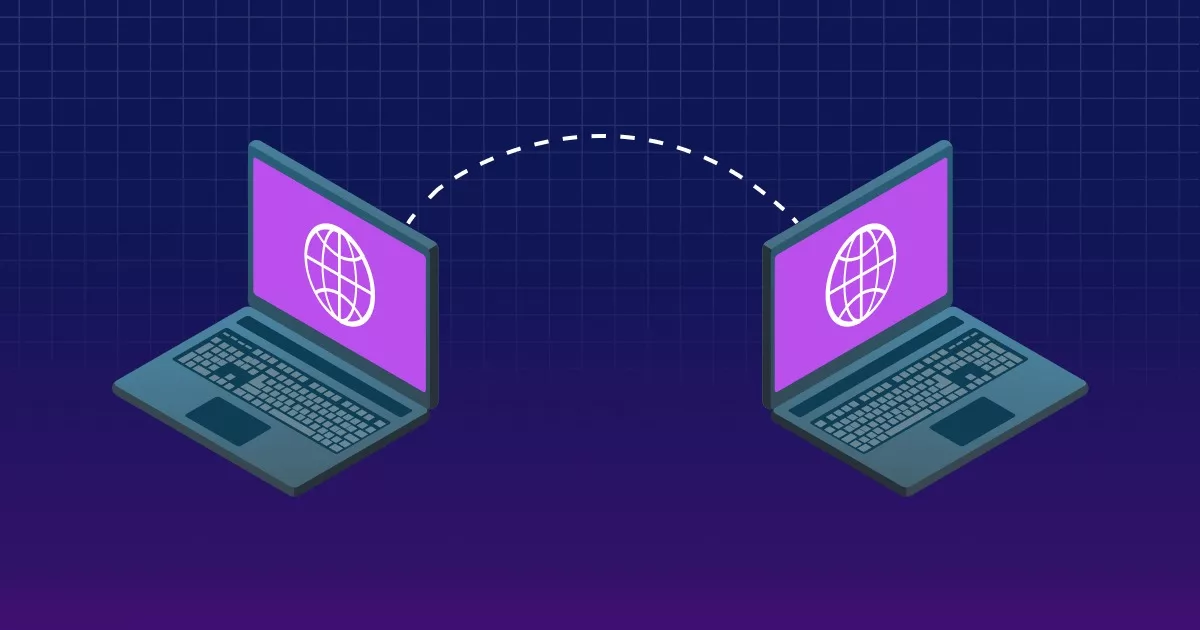
Imagine sharing files and information with anyone worldwide without a centralized server to facilitate the exchange. That’s the beauty of peer-to-peer (P2P) networking.
P2P networks allow computers to connect directly with each other, enabling users to share data without relying on a central authority.
This technology has improved the way we share information, from sharing large files to streaming videos, and has had a significant impact on the way we use the internet.
In this article, we’ll explore the world of P2P networking, how it works, and its benefits. Whether you’re a tech enthusiast or just curious about this innovative technology, you’re in for an exciting ride.
What Is Peer-to-Peer Network?
A peer-to-peer (P2P) network is a type of network where all computers or devices act as both clients and servers, allowing them to communicate and share resources without needing a centralized server or authority.
In a P2P network, each device has its own resources, such as files, processing power, and bandwidth, and can directly communicate and share these resources with other devices in the network.
P2P networks are commonly used for sharing files, such as music or movies. Still, they can also be used for messaging, gaming, and cryptocurrency transactions.
As P2P networks don’t rely on a centralized server, they can be more resilient. They can continue to function even if some devices fail or go offline.
How Do Peer-to-Peer Networks Work?
Peer-to-peer (P2P) networks connect multiple devices directly to each other, allowing them to share resources and communicate without needing a central server.
Imagine a group of friends sitting in a circle, passing a ball around. Each person can receive the ball from someone else and pass it to someone else. In a P2P network, each device acts as a receiver and a sender, allowing for direct communication between devices.
When a device wants to share a file, it breaks it into pieces and sends them to different devices in the network. Each device that receives a portion of the file can then share it with other devices that need it, creating a web of connections between them. This makes a more efficient way of sharing files. Each device can contribute to the process and reduce the load on any single device.
One of the benefits of P2P networks is their ability to distribute resources and responsibilities among all connected devices, making them more resilient and resistant to failure. If one device goes offline or fails, the network can still function because other devices can step in and take over the missing functions.
Types of Peer-to-Peer Networks
There are three types of P2P networks — unstructured, structured, and hybrid.
1. Unstructured P2P Networks
Unstructured P2P networks are easy to build as devices can be connected randomly in the network, and each device can make an equal contribution. But, due to their lack of organization, finding specific content on the network can be difficult.
Examples of unstructured P2P networks include Napster and Gnutella.
2. Structured P2P Networks
Structured P2P networks use software to create a virtual layer that organizes nodes into a specific structure. While they are more difficult to set up, they provide users easy access to the content they seek.
Examples of structured P2P networks include P-Grid and Kademlia.
3. Hybrid P2P Networks
Hybrid P2P networks combine the features of both P2P networks and client-server architecture.
In these networks, nodes can communicate directly with each other and with a central server that helps locate other nodes on the network. This type of network can be useful in cases where there is a need for both decentralized communication and a central point of control.
Applications of Peer-to-Peer Networks
P2P networks have various applications across various industries and fields.
1. File Sharing
One of the most well-known applications of P2P networks is file sharing. P2P file sharing allows users to directly share files with each other without relying on a centralized server, making it a faster and more efficient way to share large files.
2. Messaging
P2P networks can also be used for messaging and communication. Unlike traditional messaging platforms, P2P messaging allows users to communicate directly with each other without relying on a centralized server, providing a more secure and private way to communicate.
3. Gaming
Another application of P2P networks is gaming. P2P gaming allows players to connect directly to each other, creating a more interactive and social gaming experience. P2P gaming also reduces latency and improves gameplay, as players don’t have to rely on a centralized server to connect to each other.
4. Financial Transactions
P2P networks can also be used for decentralized financial transactions, such as in the case of cryptocurrencies like Bitcoin. In a P2P cryptocurrency network, transactions are directly verified and processed by the network of users, eliminating the need for a centralized financial authority.
Examples of Peer-to-Peer Networks
Below are some examples of P2P networks.
1. BitTorrent
BitTorrent is a P2P file-sharing protocol that distributes large files, such as movies, TV shows, and music. It breaks files into smaller pieces and allows users to download and share those pieces directly with each other.
2. Bitcoin
Bitcoin is a decentralized cryptocurrency that uses a P2P network to verify and process transactions. It allows users to make transactions directly with each other without the need for a centralized authority.
3. World of Warcraft
World of Warcraft is a massively multiplayer online game that uses P2P networks to connect players directly with each other.
4. Freenet
Freenet is a P2P network designed for secure and anonymous file sharing. This network uses encryption and decentralized routing to protect user privacy and security.
How Peer-to-Peer Networks Contribute to Decentralization
Peer-to-peer (P2P) networks contribute to decentralization by enabling direct communication and resource sharing between devices without a central server or authority. This allows for greater autonomy and resilience. The network can continue functioning even if some devices go offline or fail.
On the other hand, in a centralized network, a central server or authority controls all communication and resource sharing. This creates a single point of failure, making the network vulnerable to outages, security breaches, and censorship. A P2P network distributes these functions among all connected devices, creating a more robust and resilient network.
P2P networks also promote greater collaboration and sharing among individuals and devices. All devices can contribute to the network and share their resources. This can lead to more significant innovation and creativity, as individuals can build on each other’s ideas and resources.
Conclusion
Peer-to-Peer (P2P) networks have revolutionized how we share information and resources in the digital age.
P2P networks have opened up new possibilities for collaboration, innovation, and creativity by enabling direct communication between individual devices without needing a central server.
Despite some challenges, such as security concerns and legal issues, P2P networks remain a vital and dynamic part of the digital landscape, offering a decentralized and democratic alternative to traditional models of communication and exchange.
FAQs
1. What is a peer-to-peer network, and how is it different from a client-server network?
A peer-to-peer (P2P) network is a decentralized network where all nodes have equal abilities and responsibilities without a centralized server controlling the network. Each node can act as both a client and a server, and all nodes work together to distribute and share resources, such as files or computing power.
In contrast, a client-server network is a centralized network where clients request services from a server, and the server provides those services. The server controls access to the network and resources.
2. What are the advantages of peer-to-peer networks over client-server networks?
One advantage of P2P networks is that they can be more resilient and fault-tolerant than client-server networks.
If one node fails in a P2P network, other nodes can still operate, whereas a server failure in a client-server network can lead to downtime. P2P networks can also be more scalable, as nodes can join or leave the network without affecting the overall performance.
Also, P2P networks can be more secure, as there is no central point of failure or control.
3. How are peer-to-peer networks used in blockchain technology?
Blockchain technology relies on P2P networks to enable distributed consensus and verification of transactions.
Each node maintains a copy of the ledger in a blockchain network and can validate transactions without relying on a central authority.
The P2P network enables nodes to communicate and share information in a decentralized and secure way, ensuring the integrity and transparency of the blockchain.
4. How can peer-to-peer networks contribute to data sharing and collaboration?
P2P networks can facilitate data sharing and collaboration by enabling direct communication and resource sharing between nodes.
In a P2P network, nodes can share files, collaborate on projects, and share computing resources without relying on a central server or third-party intermediary. This can increase efficiency, reduce costs, and promote innovation by enabling more direct and open communication and user collaboration.
Also, P2P networks can enhance privacy and security by allowing users to share data and resources directly without intermediaries.





